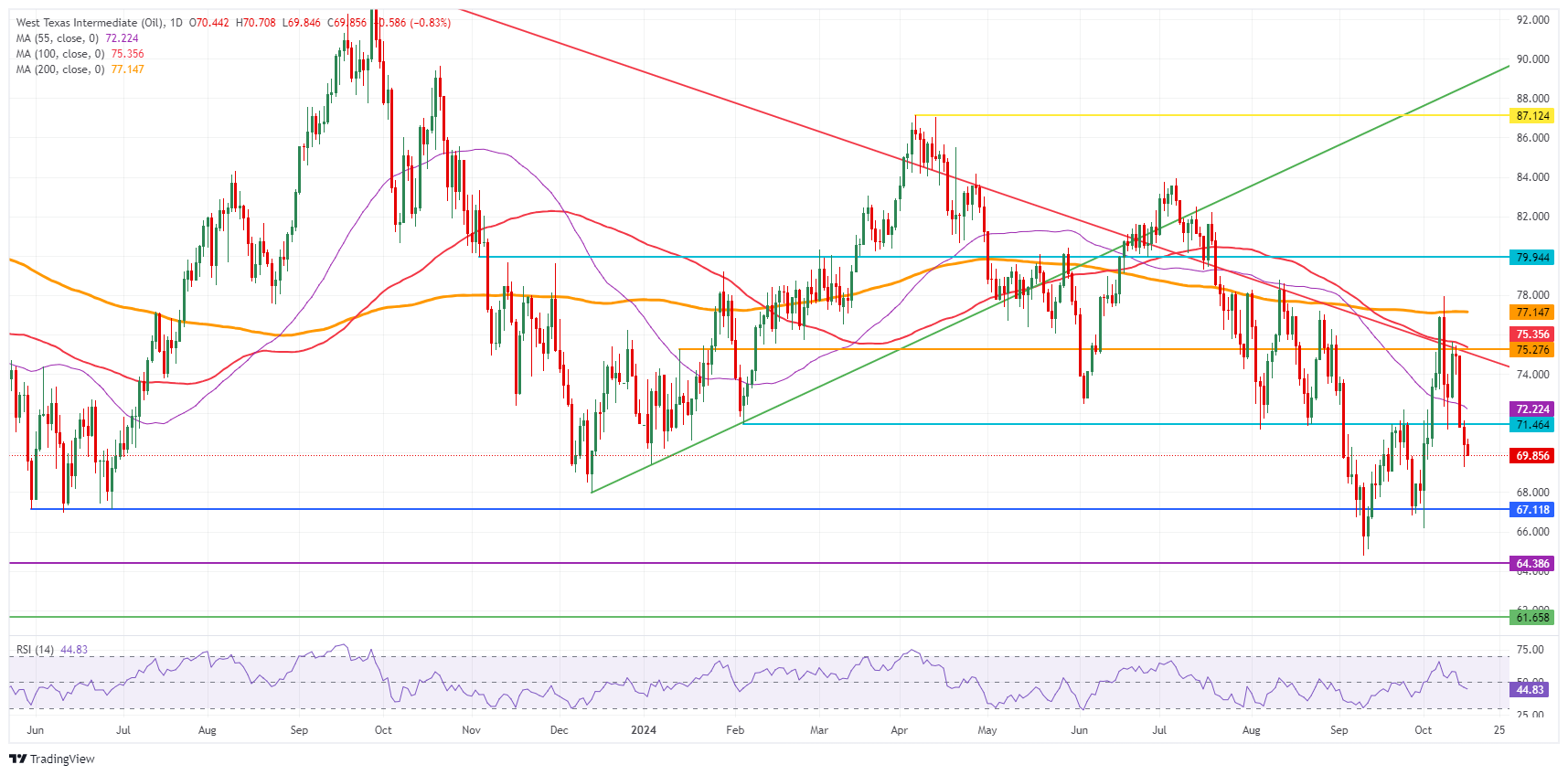- The recent correction in crude oil is receding, but losses are still over 6% so far this week.
- Oil is supported by the risk of headlines, following tough rhetoric from Israel’s opposition party to bomb Iranian oil fields.
- The US Dollar Index has broken through strong resistance on its way towards 104.00.
Crude oil is trading in the red for the fourth day in a row, although off this week’s low on Wednesday, due to harsh rhetoric from Israel’s opposition party. The comments were published in the Jerusalem Post on Tuesday and came from Yest Atid party leader Yair Lapid, who called for an immediate attack on Iranian oil fields. Such an attack would defy the US administration’s request not to do so, contributing to the escalatory spiral between the two countries and increasing the potential for broader conflict.
The US Dollar Index (DXY), which tracks the performance of the Dollar against six other currencies, is advancing to a new two-month high at levels not seen since August of this year. The dollar’s further rise came after an interview by former US President Donald Trump on Bloomberg, in which he further outlined his economic plans if he were to become president again. Traders are placing more bets on the assumption that Trump will win on November 5.
At the time of writing, crude oil (WTI) is trading at $70.06 and Brent crude is trading at $73.96.
Oil news and market factors: API expected later this Wednesday
- Libyan crude oil is expected to accelerate its production and export schedule by October to 27.52 million barrels per month or 888,000 barrels per day, according to a loading schedule seen by Bloomberg News.
- Crude oil prices were little changed in European trade on Wednesday amid uncertainty over the future of the conflict in the Middle East and the effects of production cuts maintained by the Organization of the Petroleum Exporting Countries (OPEC) and allied producers until December, Reuters reports.
- Weekly crude oil stock change numbers from the American Petroleum Institute will be released at 20:30 GMT. An increase of 2.3 million barrels is expected, smaller than the increase of 10.9 million recorded a week earlier.
Oil Technical Analysis: Line in the Sand at $70.00
Crude oil is trying to hold the $70.00 marker, but it will not be an easy task. With OPEC set to turn on the oil spigot soon and supply remaining sluggish, there isn’t much upside potential present. Geopolitical tensions seem to be easing a bit but remain high, which doesn’t help either, so traders are looking for a stable fair value for oil, which could be below $70.00.
There is a challenging path to recovery for crude oil. First, the pivot level at $71.46, which was strong enough to catch the falling knife on Monday, must recover again with a daily close above it. From there, the sizable technical level at $75.35, with the 100-day SMA and some pivot lines, is possibly the first major hurdle ahead.
On the downside, that previously mentioned pivot level of $71.46 has now become resistance and is no longer valuable as support. Instead, traders should look much lower, to $67.11, a level the price supported in May-June 2023. Should that level be broken, the year-to-date low of 2024 emerges. at $64.75, followed by $64.38, the 2023 low.
US WTI Crude Oil: Daily Chart
WTI Oil FAQs
WTI oil is a type of crude oil that is sold in international markets. WTI stands for West Texas Intermediate, one of the three main types that include Brent and Dubai crude. WTI is also known as “light” and “sweet” for its relatively low gravity and sulfur content, respectively. It is considered a high-quality oil that is easily refined. It is sourced in the United States and distributed through the Cushing facility, considered “the pipeline junction of the world.” It is a benchmark for the oil market and the price of WTI is frequently quoted in the media.
Like all assets, supply and demand are the main factors that determine the price of WTI oil. As such, global growth can be a driver of increased demand and vice versa in the case of weak global growth. Political instability, wars and sanctions can alter supply and impact prices. The decisions of OPEC, a group of large oil-producing countries, is another key price factor. The value of the US Dollar influences the price of WTI crude oil, as oil is primarily traded in US dollars, so a weaker Dollar can make oil more affordable and vice versa.
Weekly oil inventory reports published by the American Petroleum Institute (API) and the Energy Information Agency (EIA) influence the price of WTI oil. Changes in inventories reflect the fluctuation of supply and demand. If the data shows a decline in inventories, it may indicate an increase in demand, which would drive up the price of oil. An increase in inventories can reflect an increase in supply, which drives down prices. The API report is published every Tuesday and the EIA report the next day. Their results are usually similar, with a difference of 1% between them 75% of the time. EIA data is considered more reliable since it is a government agency.
OPEC (Organization of the Petroleum Exporting Countries) is a group of 13 oil-producing nations that collectively decide member countries’ production quotas at biannual meetings. Their decisions often influence WTI oil prices. When OPEC decides to reduce quotas, it can restrict supply and drive up oil prices. When OPEC increases production, the opposite effect occurs. OPEC+ is an expanded group that includes ten other non-OPEC member countries, including Russia.
Source: Fx Street
I am Joshua Winder, a senior-level journalist and editor at World Stock Market. I specialize in covering news related to the stock market and economic trends. With more than 8 years of experience in this field, I have become an expert in financial reporting.








